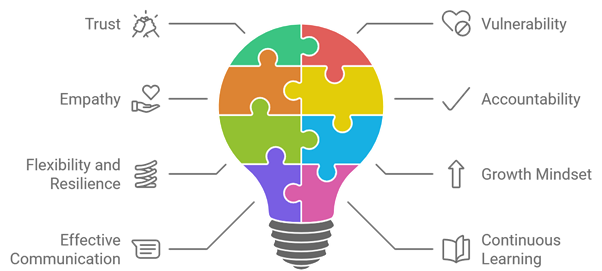In an era where automation and digital transformation are reshaping industries, the role of leadership has evolved. The old mindset that “work is who we are” is shifting. Today, work is something we do, not something that defines us entirely. As a current regional tech leader of a team of Power Platform specialists, and with 12 years of experience in the tech industry, including 6 years running a business, and learning from some of the best minds in the coaching space, I’ve learned that leadership isn’t about being the loudest voice or the toughest taskmaster. It’s about being a supporter.
The world is moving faster, and people are feeling the pressure. The line between personal and professional life has blurred, and it’s our job as leaders to recognize that. Whether we’re parents raising children or professionals guiding a team, the core principles remain the same. As a mother of two, I’ve found that being a parent has taught me invaluable lessons about leadership. Like raising children, leading a team requires balance: giving space for people to solve their own problems, setting firm boundaries, and offering gentle reminders. It’s not about being a pushover; it’s about being firm yet compassionate.
Leadership in an Automated World
With the rise of automation, the traditional notion of work is being redefined. Jobs that once demanded intense focus and long hours are now supplemented or replaced by intelligent systems, shifting how people view their professional identities. Increasingly, individuals no longer see themselves solely through the lens of their job titles—they’re seeking more balance, purpose, and opportunities for growth in both their personal and professional lives. As the nature of work evolves, so too does the role of leadership. It’s no longer just about driving productivity; it’s about guiding people toward fulfilling, meaningful careers that align with their broader life goals.
At the same time, the fast pace of modern life has brought new challenges. The digital age has made people more accessible than ever before, blurring the lines between work and personal time. This constant connectivity, coupled with heightened pressures to be always “on,” has led to rising levels of stress and burnout. People feel overwhelmed by the demands of always being productive, successful, and available, often at the cost of their well-being. The complexities of global uncertainty and economic shifts only add to this burden, contributing to the mental health challenges many now face.
In response, leaders must take a more proactive role in supporting their teams. The focus should shift from managing tasks to nurturing the human elements of work—creativity, emotional intelligence, and critical thinking. By fostering environments that promote continuous learning and personal development, leaders can help employees find meaning in their contributions, encouraging them to grow both professionally and personally. Creating space for balance, well-being, and purpose not only benefits individuals but leads to a more motivated and engaged workforce that’s better equipped to thrive in the rapidly changing landscape of work.
Support vs. Control: The New Leadership Paradigm
One of the biggest lessons I’ve learned as a leader is the power of support. When my team knows that I’m there to listen, understand, and guide—not just control or solve their problems for them—they feel more empowered. And the results speak for themselves. Employees who feel supported are more productive, more innovative, and more loyal to the organization.
In my leadership journey, I intentionally take time to understand where each person is in their own journey. The same way I guide my children to solve their own problems, I encourage my team to develop their problem-solving skills. This doesn’t mean I step back completely; it means I’m there with gentle nudges, offering positive reinforcement. In fact, a golden rule I’ve adopted from parenting is to offer eight positive comments for every two pieces of constructive feedback. It builds trust, fosters confidence, and creates a healthy, resilient team.
Key Principles of Effective Leadership
In today’s fast-paced, ever-changing world, leaders must adapt their approach to inspire and guide their teams. While every leader brings their own style, a few key principles stand out as essential for creating a supportive and productive work environment. Below are my collated perspective on the core pillars of effective leadership:

- Trust is the foundation of every successful team. Without it, collaboration falters, and innovation stalls. As a leader, building trust begins with transparency and consistency. Be clear in your communication, set realistic expectations, and follow through on commitments. Trust is a two-way street—just as we expect our teams to trust us, we must trust them to perform, problem-solve, and innovate. Empowering people to make decisions fosters ownership and strengthens team dynamics.
- Vulnerability might seem like a weakness, but in leadership, it’s one of the greatest strengths. When leaders are willing to admit they don’t have all the answers, it creates an environment where others feel comfortable sharing ideas, asking questions, and making mistakes. Vulnerability encourages a culture of openness and authenticity, which leads to greater innovation and collaboration. As a mother of two, I’ve learned that admitting when I don’t have all the solutions shows my kids—and my team—that learning is a continual process.
- Empathy is the ability to understand and share the feelings of another person. As a leader, it’s crucial to recognize that each individual on your team has their own personal challenges and aspirations. Taking the time to truly listen and understand their perspectives builds stronger relationships and fosters a culture of support. Empathy is key in balancing the pressures of work with the realities of life, helping employees feel valued and understood.
- Accountability is about setting clear expectations and holding both yourself and your team accountable for outcomes. It’s not about blame, but about creating an environment where everyone feels responsible for the team’s success. This means celebrating wins together and learning from mistakes. Setting boundaries and clearly defining roles ensures that people have the structure they need to excel while understanding their individual and collective responsibility.
- Flexibility and Resiilience in a world that’s constantly evolving, flexibility is critical. Leaders who are adaptable to change and open to new ways of thinking are better equipped to guide their teams through periods of uncertainty. Flexibility isn’t just about responding to external changes; it’s about creating a work environment that allows for different working styles, schedules, and personal needs. With work-life balance more important than ever, flexible leadership shows your team that you respect their lives outside the office.
- Fostering a Growth Mindset means encouraging your team to continuously learn and improve. It’s about viewing challenges as opportunities rather than obstacles. As a leader, I encourage my team to embrace learning by offering guidance when needed but also giving them space to develop their own solutions. When we promote a culture of curiosity and learning, we set the stage for long-term success.
- Effective communication is vital for any leader. This includes not only conveying information clearly but also being an active listener. Leaders should encourage feedback and create an environment where team members feel comfortable sharing their ideas and concerns. Good communication helps to prevent misunderstandings and promotes a culture of collaboration
- Continuous learning and development is prioritized for their own growth as well as the development of their team. They seek opportunities for learning, whether through formal training, mentorship, or self-directed study. By promoting a culture of continuous improvement, leaders can ensure that their team remains competitive and innovative.
Statistics Don’t Lie: Support Equals Success
When we foster environments of personal and professional growth, we contribute to the long-term success of our businesses. After all, a happy, healthy employee leads to a healthy bottom line. Studies show that employees who feel supported by their managers are 70% less likely to experience burnout and 78% more likely to feel engaged at work. The ripple effects are clear: happier employees lead to better business outcomes, lower turnover rates, and stronger innovation.
Research consistently shows that supportive leadership has measurable benefits. According to Gallup, organizations with highly engaged employees outperform their peers by 147% in earnings per share. Furthermore, workplaces with strong leadership and employee support systems experience 41% lower absenteeism, 59% lower turnover, and a 21% increase in profitability.
When we focus on creating environments where people feel supported—where they can grow and thrive—everyone wins. And in a world where burnout and disengagement are on the rise, being a leader who prioritizes personal and professional growth isn’t just a nice-to-have, it’s essential.
The Future of Leadership
In today’s dynamic world, leadership is less about hierarchy and more about collaboration. As we embrace automation and new technologies, it’s more important than ever to lead with empathy, support, and encouragement. Our teams are made up of individuals with personal goals, challenges, and dreams. As leaders, it’s our responsibility to recognize this and create environments that nurture both personal well-being and professional growth.
In doing so, we’ll build more resilient, innovative teams that will drive success—not just for the business, but for each individual’s journey as well. A healthy team is a productive team, and in today’s fast-paced world, that’s the ultimate measure of success.


Leave a Reply